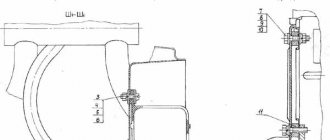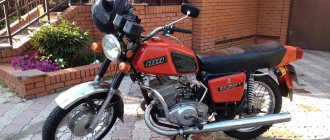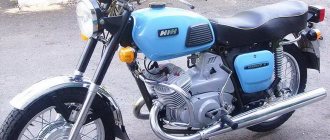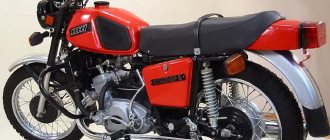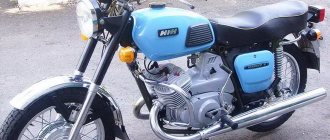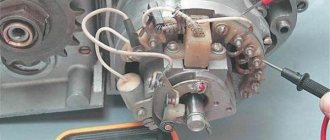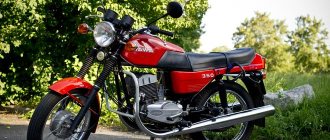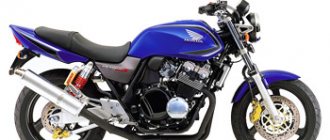If residents of USSR cities preferred Java motorcycles, then in rural areas the equipment produced by the Izhevsk Machine-Building Plant took root well. The production of the first model of the Izh Jupiter family began in 1961. Despite the fact that its design was quite successful, the developers did not rest on their laurels and regularly improved the equipment produced at the enterprise. In 1971, motorcycle lovers had the opportunity to buy the third generation of Soviet bikes - the Izh Jupiter 3 motorcycle.
Technical characteristics of the basic modification
The new model, although it retained many of the technical solutions that had proven themselves in early modifications, became a significant step forward, having changed both in appearance and in technical characteristics.
The appearance of the car was quite consistent with the design ideas of that time. The technical characteristics looked impressive even in comparison with the parameters of the Java 350 type 634, which appeared a year later.
- The engine is a two-stroke, with two cylinders arranged in a row, and is started by a kickstarter. With the same working volume as Izh Jupiter-2 - 347 cubic meters. see, the power of the power unit has increased almost one and a half times, from 19 to 25 hp. With. Having redesigned the cylinder block and cylinder head, the designers changed the shape and location of the cooling fins, significantly improving the temperature conditions at different speeds.
- Ignition of Izh Jupiter 3 is contact, separate for each cylinder.
- The power system is carburetor, with fuel supplied from the tank by gravity. The standard configuration uses a K-62 carburetor.
- The foot-switched gearbox has four stages and is integral with the engine. The rear wheel drive is chain.
- Clutch - with a multi-plate clutch placed in an oil bath. Control - cable, located on the steering wheel.
- Tubular frame, the design of which uses pipes of different sections.
- The front telescopic fork with increased shock absorber travel is designed for comfortable movement not only on the highway, but also on rough terrain.
- The rear suspension on telescopic shock absorbers turned out to be quite soft, increasing the ride comfort of the Izh Jupiter 3 motorcycle.
- The maximum speed was 120 km/h.
- Fuel tank volume – 18 l. Taking into account the fact that fuel consumption per 100 km is 3.7 liters, a distance of 480 km can be covered on one tank without refueling.
- The dry weight of the Izh Jupiter 3 motorcycle, without oil and fuel, is 162 kg.
A robust design, energy-intensive suspension, a fairly high ground clearance of 135 mm and a high-torque engine made it possible to operate the car on rural roads, where more gentle vehicles openly gave in.
Principle and features of control
The sidecar in motorcycles is used to seat passengers and to place cargo in the trunk, in which a spare wheel can be mounted. Sometimes a stroller may only serve as cargo and not be intended for passengers.
Depending on the traffic rules, the stroller will be placed on a certain side. When driving on the left, the stroller is on the left side; when driving on the right, it is on the right.
This unit has some similarities with a tricycle, but a motorcycle with a sidecar is less symmetrical. The sidecar wheel moves forward and rotates slightly inward compared to the rear wheel of a motorcycle. The motorcycle itself is placed slightly at an angle from the sidecar so that the sidecar does not pull the motorcycle along with it. A special damper is installed on the steering wheel, which prevents vibrations.
Motorcycles with a sidecar can, according to their operation, detach the sidecar if they can move without it. Much depends on the drive of the motorcycle, for example, it can be installed on the rear wheel, or on the wheel of a sidecar, the cross-country ability of the motorcycle depends on this.
The motorcycle sidecar system has a hand brake that acts on the front wheel and a foot brake that acts on the rear wheel and the sidecar wheel. All motorcycles are equipped with a parking brake to keep the vehicle stationary.
The gearbox in such units can be installed for reverse gear; in addition, special headlights, turn signals, brake lights, sometimes “finder lights,” fog lights and other types of optics are installed.
It will also be interesting: Review of the Voskhod 2 motorcycle: motorcycle legend of the USSR
When you ride such a motorcycle, you do not need to keep your balance; the only thing you need to take into account during acceleration and braking is that the motorcycle can pull the driver to the side. If you turn sharply to the side, the sidecar wheel can come off and overturn the motorcycle with the driver.
It is interesting that in many sports motorcycle disciplines where motorcycles with sidecars are used, not only the driver, but also the passenger participates in the race. The passenger actively prevents the motorcycle from tipping over and, while in the sidecar, controls the turns of the motorcycle. Below is a photo of a motorcycle with a sidecar, which shows how clearly the spare fuel tank is placed; you can safely ride long distances.
A stroller is a must
Economic motorcyclists preferred the Izh Jupiter 3 with a sidecar, the design of which made it possible to carry not only a third passenger, but also a fair amount of cargo. First, the BP 65 model was installed. Then it was replaced by a new modification BP-1, which had a sliding top for ease of passenger boarding.
Installing a side trailer requires wheel alignment. Adjustment is made by moving the front side hinge on the frame. The motorcycle, equipped with a sidecar, was marked Izh Jupiter-3K. More practical was, perhaps, the M-72 Ural.
Motorcycle "Izh"
Izh motorcycles began to be produced in the city of Izhevsk 60 years ago. Over such a long period of time, about 12 million motorcycles of various models were produced. The most famous among them was the Planet motorcycle, as it was one of the first motorcycles that was produced with a sidecar. The Izh motorcycle with a sidecar made it possible to transport children up to 12 years old; they were reliable and safe. Often such transport was used for trips to the village or traveling with the wind, which was impressive at that time. The trailer could be used to transport things, and since a motorcycle is an inexpensive form of transport, it was an excellent replacement for a passenger car and was capable of carrying up to three people.
It’s not for nothing that after such transport, the demand for cars fell sharply. Over the entire period of production of Izh motorcycles, the color scheme changed; there were black, blue, red and light brown shades. Later, cargo side trailers, types of stationary engines were improved and fire safety equipment was installed. However, after the heavy debts of the Izhmoto plant, production was mothballed in 2008 for an unknown period.
You may also be interested in: Motocross: champions of cross-country motorcycles
Additional modifications
During production, the car was modified twice. From 1977 to 1980, Izh Jupiter 3 01 was produced, which had a number of differences from the basic version. The model received:
- Possibility of adjusting the gap between the mudguard and the wheel. This was important when operating on country roads.
- Anti-theft lock. In connection with this, the ignition switch circuit has changed.
- Safety bars.
- Standard rear view mirror.
- The rear shock absorbers are of a new design with three positions of stiffness adjustment.
- Changed design of mufflers.
- Rear brake locking, making it easier to install on the parking stop.
There were a number of other minor changes, but they mainly concerned the appearance. As for the performance characteristics, they remained at the same level. From 1979 to 1981, the Izh Jupiter 3 02 was produced, the main difference of which was the fuel tank of a new design and shape.
Main disadvantages
All modifications were marked with a quality mark and were generally reliable. Owners of equipment made at the Izhevsk Machine-Building Plant were given headaches by:
- A weak generator, the power of which was not enough to power all electrical appliances at night.
- An ignition system made according to a separate circuit for each cylinder. In general, it is quite reliable, but setting the ignition evenly on the Izh Jupiter 3 is not an easy task.
- The electrical wiring is not of entirely satisfactory quality. Owners of new cars often complained that the wires were mixed up at the factory.
Nevertheless, the popularity of the model was great, and if anything stopped potential buyers, it was the fairly high price. Over the course of a year, the plant produced over 250,000 cars that went on public sale. The successful design became the basis for the creation of the following modifications, the latest of which was Izh Jupiter-5.
Having bought the new Izh Jupiter 5 in 2008, I was incredibly happy.
The sidecar was attached to the motorcycle right away.
I always dreamed about her. Local kolkhosaurs began to prove, foaming at the mouth, that the side trailer was terrible, as if they themselves had to ride with it. I didn’t listen to anyone, because I had to live my own life. When they described the nightmares of the VMZ cradle to me, only a condescending smile appeared on my face. The devil is not as scary as he is painted, is he? After installation, the brakes were carefully adjusted on the stroller, and I went on my first trip with it to gain experience.
Practical operation has completely dispelled all the myths about the impossibility of fully operating a motorcycle with a side trailer. Everyone shouted that it was unbearable to drive the stroller. After adjusting the wheel alignment, the motorcycle was easily controlled with one hand. Subsequently, I covered any roads without any problems without stopping to rest. Locals were talking about the incredible increase in fuel consumption. Apparently, they relied on their meager experience. The lack of licenses and documents for a motorcycle did not allow them to travel further than a radius of three kilometers from their home village along a country road. Naturally, there you move at a ragged pace at lower levels, where gasoline pours as if into a hole. I drove along the highway in direct gear at a uniform speed. An unloaded motorcycle always managed 6l/100 km. If there were three of us traveling and carrying 20 kilograms of some kind of shmurdyak in the trunk of the stroller, then the consumption could increase to 7.5 liters. But this again depends on the headwind/tailwind, the abundance of ups/downs of the road, and the frequency of switching up/down. In the end, 10 liters per hundred is not some kind of hell. The “experts” claimed that with a stroller I would inevitably tip over sooner or later. Neither then nor now do I understand how. According to their logic, it turned out that the designers and VSW deliberately created a killer transport. No, I’m not saying anything, you can roll over even in a car with four points of support on the ground, but if you have at least a little common sense, then you’re unlikely to let something like that happen. Of course, during operation there were emergency braking situations and the motorcycle began to nod heavily. But again, everything was within normal limits. In order to roll forward over your head, you just need to stupidly hit an obstacle. While driving, the Izh initially made me afraid of capsizing on the left side. After traveling for a day, I realized that it was in vain. The feeling of the stroller came very quickly. Subsequently, turning to the right, lifting the side trailer into the air, became even fun. If you don't exceed a reasonable speed limit, it won't rise. At first I instinctively stuck my leg out to the left for support. Then the stupid habit of doing this went away as quickly as it came. Fellow villagers insisted that a motorcycle with a sidecar would overheat on long trips in the summer. What will it do with a properly adjusted ignition, carburetor, and the required composition of the gas-oil mixture? The fin area of the cylinders is quite sufficient for heat removal. My motorcycle has never overheated, although I have been stuck in traffic jams during rush hour in Nizhny Novgorod on a summer afternoon. On the highway the airflow is generally normal. It is believed that the right cylinder works in better conditions; supposedly the stroller cuts the air with its nose, directing the flow towards it. I don’t know, I won’t say – it’s impossible to accurately measure the temperature differences by hand.
After installing the stroller, I achieved the results I was looking for. If you need to travel along a rain-washed country road, you always know that you won’t fall. When slipping, it is convenient to stand on the rear pegs, rocking the motorcycle up and down. The stroller made it possible to use the motorcycle all year round. I traveled around the Nizhny Novgorod region in winter without any fear. I didn’t change tires for the cold season of the year, driving on a standard station wagon K-102. If drifts occurred, they were easily eliminated by appropriate movement of the steering wheel and body. With the stroller it became possible for three people to travel. It allowed you to take a significant load with you, and it was protected from external influences and prying eyes. When passing through pits, the comfort of the motorcycle has increased.
The only drawback was the low cruising speed on the highway, ranging from 60 to 70 km/h. But, in principle, there is even some positive in this. You drive slowly, admiring the scenery.
If you are still in doubt whether or not to make yourself a stroller, my advice is to do it without hesitation, you will definitely like it!

